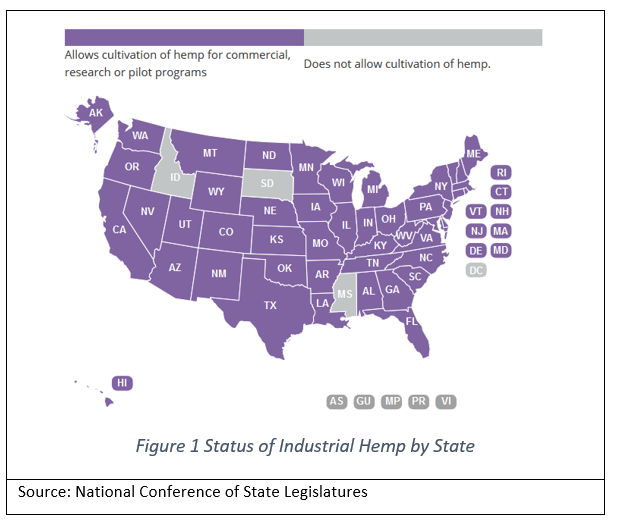What do rope, shoes, plastics, food and beverages, animal feed, auto parts, fuel, sails, textiles, paper, canvas, building supplies, body lotions and salves have in common? They can all be made with the fiber, seeds or oil of hemp.
The scientific name for industrial hemp is Cannabis Sativa L. It tends to have lower levels of Tetrahydrocannabinol (THC), a hallucinogen, than found in its cousin Cannabis Indica L commonly referred to as marijuana. Another ingredient found in both plants is Cannabidiol (CBD) which can be used in medicinal products for pain relief and reduction of epileptic seizures
Hemp was an essential cash crop for colonial farmers. George Washington, Thomas Jefferson and James Madison were just a few of the colonial estate owners who raised hemp which was primarily used for naval rope. Hemp production was banned by US drug policy in the 1930’s. During World War II the US Department of Agriculture launched a campaign to encourage hemp cultivation to replace imports from Japan.1
The Agricultural Act of 2014 (Farm Bill) legalized the growing and cultivating of industrial hemp for research purposes in states where such growth and cultivation is legal under state law. However, the legislation was limited to growth and cultivation by an institution of higher education or state department of agriculture for purposes of agricultural or other academic research or under the auspices of a state agricultural pilot program for the growth, cultivation, or marketing of industrial hemp. The bill allows the production of hemp with a THC concentration level of not more than 0.3% on a dry weight basis. State departments of agriculture were authorized to establish regulations to carry out these programs.2
The 2018 Farm Bill legalized the production of hemp as an agricultural commodity and removed it from the list of controlled substances. The bill also listed hemp as a covered commodity under crop insurance. At least 10 states and the District of Columbia have legalized marijuana both medically and recreationally. Another 23 states have approved medical marijuana. Figure 1 below shows that only 3 states and the District of Columbia have not approved the cultivation of hemp for commercial, research or pilot programs.

According to the 2018 Farm Bill, the US secretary of agriculture is also required to conduct a study of the hemp-related agricultural pilot programs implemented under the 2014 Farm Bill, along with any other agricultural and academic research on the subject, to determine the economic viability of a domestic hemp market. However, a system in which producers can grow it as freely as other crops was not created. The bill outlined actions that would be considered violations of the law:
- Producing a plant with higher than 0.3 percent THC content is prohibited
- Cultivating hemp without a license
- Includes potential punishments and what happens to repeat offenders
The bill also sets up a shared state and federal regulatory authority over the issue, outlining the steps a state must take to develop a plan to regulate hemp and submit it to the Secretary of Agriculture for approval.
There is bound to be a lot of confusion and contention between the industrial hemp industry and the medical and recreational marijuana industries. Some of the issues everyone will be dealing with are:
- Developing and protecting strains of hemp that produce plants with a THC concentration level of not more than 0.3% on a dry weight basis.
- Establishing regulations for licensing the production of industrial hemp seeds
- Establishing regulations for licensing the production of products containing THC or Cannabidiol (CBD)
- In those states where growing marijuana is legal, contention with industrial hemp growers regarding cross pollination risk.
- Determining the financial viability of the industrial hemp industry (beware of industry sponsored studies)
- Dependable markets for the product grown by farmers
- Profitability of growing industrial hemp (cost of inputs vs income received)
- Determining the type and location of processing facilities (feasibility and site selection)
- Impact of production diverted from other crops
- Cost to state governments attributed to regulation of the industry
- Sources of funding for the authorized research
Our team at Decision Innovation Solutions is following this new and changing industry and stands ready to assist government, academic, and production interests with independent and analytical research addressing the challenges listed above and many others likely to arise.
1 Source: National Conference of State Legislatures, June 2014
2 https://www.federalregister.gov/documents/2016/08/12/2016-19146/statement-of-principles-on-industrial-

